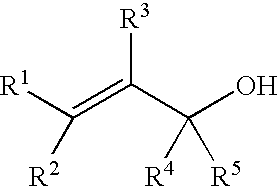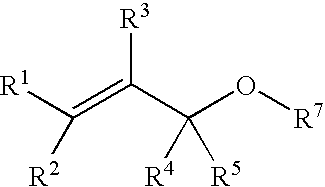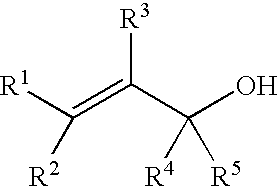Process for producing ether compounds in presence of a copper (II) salt
a technology of divalent copper and ether, which is applied in the preparation of ether, organic compound/hydride/coordination complex catalyst, physical/chemical process catalyst, etc., can solve the problem of not being able to obtain sufficient high yield in the case of another alcohol compound, and the limited amount of alcohol compounds which are usable for this purpose, etc. problem, to achieve the effect of high selectivity
- Summary
- Abstract
- Description
- Claims
- Application Information
AI Technical Summary
Benefits of technology
Problems solved by technology
Method used
Image
Examples
examples
Description of Terms in Examples and Comparative Examples
Conversion of Raw Material Compound
Conversion of Ally Alcohol in Etherification Reaction of Allyl Alcohol
[0090] This conversion shows a molar ratio of allyl alcohol which has been consumed during the etherification reaction, to ally alcohol charged before the reaction. The conversion was calculated according to the following formula: Conversion (%)of allyl alcohol=100×{allyl alcohol consumed (mol)} / {amount of allyl alcohol charged beforereaction (mol)}
Conversion of n-Butyl Alcohol in Etherification Reaction Between n-Butyl Alcohol and Allyl Alcohol
[0091] This conversion shows a molar ratio of n-butyl alcohol which has been consumed during the etherification reaction, to n-butyl alcohol charged before the reaction. The conversion was calculated according to the following formula: Conversion (%)of n-butyl alcohol=100×{n-butyl alcohol consumed (mol)} / {amount of n-butyl ...
example 1
Etherification Reaction of Allyl Alcohol
[0109] An etherification reaction of allyl alcohol was conducted by using a 1 L-volume glass autoclave reaction apparatus (HYPERGLASSTER TEM-V1000N, mfd. by Taiatsu Techno Corporation) equipped with a stirring shaft coated with Teflon (registered trademark) and a thermocouple for measuring the internal temperature. In the reactor, 350 g (6.03 mol) of allyl alcohol and 10.28 g (60.3 mmol) of copper(II) chloride dihydrate (mfd. by Wako Pure Chemical industries, Ltd., guaranteed reagent) were added. The reactor was tightly closed and no leakage within the system was confirmed by conducting an air-tightness test using nitrogen. Thereafter, the pressure in the system was returned to atmospheric pressure, stirring was conducted at a rotation number of 350 rpm, and the power of a heater outside the reactor was turned on to start heating. The time point at which the temperature inside the reactor reached 150° C., was assigned as the reaction starting...
example 2
Etherification Reaction of Allyl Alcohol
[0110] The procedure was repeated in the same manner as in Example 1, except that the etherification reaction was conducted at a reaction temperature of 155° C. and the reaction time was changed to 2.0 hours. The reaction results are shown in the above Table 1.
PUM
| Property | Measurement | Unit |
|---|---|---|
| boiling point | aaaaa | aaaaa |
| boiling point | aaaaa | aaaaa |
| boiling point | aaaaa | aaaaa |
Abstract
Description
Claims
Application Information
 Login to View More
Login to View More - R&D
- Intellectual Property
- Life Sciences
- Materials
- Tech Scout
- Unparalleled Data Quality
- Higher Quality Content
- 60% Fewer Hallucinations
Browse by: Latest US Patents, China's latest patents, Technical Efficacy Thesaurus, Application Domain, Technology Topic, Popular Technical Reports.
© 2025 PatSnap. All rights reserved.Legal|Privacy policy|Modern Slavery Act Transparency Statement|Sitemap|About US| Contact US: help@patsnap.com



